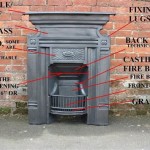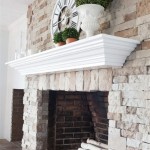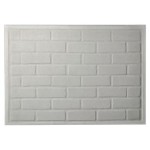How to Make a Faux Fireplace
A faux fireplace, or decorative fireplace, provides the aesthetic appeal and cozy ambiance of a traditional fireplace without the need for venting, gas lines, or extensive structural modifications. It serves as a focal point in a room, adding character and visual interest. Creating a faux fireplace is a manageable DIY project that can be customized to fit various design styles, from rustic farmhouse to modern minimalist. This article outlines the steps involved in constructing a faux fireplace, covering planning, materials, building the frame, finishing the exterior, and adding decorative elements.
Planning and Design Considerations
Before commencing the construction process, meticulous planning is essential. The initial step involves determining the desired location and size of the faux fireplace. Consider the dimensions of the room and the placement of existing furniture to ensure the fireplace complements the overall space. A fireplace that is disproportionately large or small for the room can detract from its aesthetic appeal.
Next, select a design style that aligns with the existing decor. Research different fireplace designs online and in home décor magazines to gather inspiration. Options range from traditional brick fireplaces with ornate mantels to contemporary designs with clean lines and minimalist detailing. The chosen design will dictate the materials and construction methods needed.
Once a design is selected, create a detailed sketch or blueprint of the fireplace. This should include accurate measurements of all components, including the width, height, and depth of the firebox opening, the mantel, and the surrounding structure. A well-defined plan will minimize errors during the construction phase and ensure a professional-looking final product.
Finally, consider the intended use of the fireplace. Will it serve purely as a decorative element, or will it house electric candles, a small electric heater, or other functional features? The intended use will influence the design and construction of the firebox area and may require the inclusion of electrical outlets or ventilation.
Materials and Tools Required
The materials needed for a faux fireplace will vary depending on the chosen design, but certain core components are common to most projects. These include:
*Framing Lumber:
Typically 2x4 lumber is used to construct the structural frame of the fireplace. The quantity needed will depend on the overall size and complexity of the design. *Plywood or MDF:
These materials are used to create the flat surfaces of the fireplace, such as the firebox surround and the mantel supports. *Facing Material:
This is the material that will be visible on the exterior of the fireplace. Options include faux brick panels, stone veneer, wood planks, or tile. *Trim:
Various types of trim, such as baseboard, crown molding, and decorative molding, can be used to add detail and visual interest to the fireplace. *Mantel:
The mantel can be made from solid wood, reclaimed wood, or a composite material. *Fasteners:
Screws, nails, and construction adhesive are needed to assemble the various components of the fireplace. *Paint or Stain:
Depending on the chosen facing material, paint or stain may be required to finish the exterior of the fireplace.In addition to these materials, several tools will be needed for the construction process. These include:
*Measuring Tape:
For accurate measurements of all components. *Level:
To ensure the fireplace is plumb and level. *Saw:
A circular saw or miter saw is needed to cut the framing lumber, plywood, and trim. *Drill/Driver:
To install screws and fasteners. *Nail Gun (Optional):
A nail gun can speed up the assembly process. *Stud Finder:
To locate wall studs for anchoring the fireplace. *Safety Glasses:
To protect eyes from debris. *Dust Mask:
To avoid inhaling dust and particles.Building the Frame
The construction of the frame is the foundational step in building a faux fireplace. The frame provides structural support and serves as the base for attaching the facing material and decorative elements.
Begin by cutting the framing lumber according to the dimensions specified in the plan. Use a miter saw to make precise cuts, ensuring that the corners are square. Assemble the frame using screws or nails, creating a sturdy and rigid structure. Pay close attention to the stability of the frame, as it will bear the weight of the facing material and mantel.
Once the basic frame is assembled, add additional framing members to support the firebox opening and the mantel. Ensure that these supports are securely attached to the main frame. The firebox opening should be sized according to the desired dimensions of the decorative insert or electric heater that will be placed inside.
Attach the frame to the wall using screws or nails. Use a stud finder to locate the wall studs and anchor the frame to these studs for maximum stability. If the frame cannot be directly attached to studs, use drywall anchors or toggle bolts to provide adequate support. Ensure the frame is plumb and level before securing it to the wall.
After the frame is attached to the wall, cover the exposed framing members with plywood or MDF. This will create a smooth and even surface for attaching the facing material. Cut the plywood or MDF to size using a circular saw and attach it to the frame using screws or nails. Fill any gaps or imperfections with wood filler and sand smooth to create a seamless surface.
Finishing the Exterior
The exterior finish of the faux fireplace is what determines its aesthetic appeal. Careful selection and application of the facing material and trim can transform the frame into a convincing replica of a traditional fireplace.
Begin by preparing the surface of the plywood or MDF by sanding it smooth and applying a primer. This will ensure that the facing material adheres properly and provides a uniform finish. Select the desired facing material, such as faux brick panels, stone veneer, wood planks, or tile. Cut the facing material to size using appropriate tools, such as a wet saw for tile or a miter saw for wood planks.
Apply the facing material to the plywood or MDF using construction adhesive or mortar, following the manufacturer's instructions. Ensure that the facing material is evenly spaced and aligned to create a professional-looking finish. Use spacers to maintain consistent grout lines when installing tile or stone veneer.
Once the facing material is installed, install the trim around the edges of the fireplace. This will conceal any exposed edges and add a decorative touch. Choose trim styles that complement the overall design of the fireplace. Cut the trim to size using a miter saw and attach it to the fireplace using nails or construction adhesive. Caulk any gaps between the trim and the facing material to create a seamless finish.
Install the mantel on top of the fireplace. The mantel can be attached using screws or construction adhesive, depending on its weight and size. Ensure that the mantel is level and securely attached to the fireplace. Consider adding decorative corbels or brackets beneath the mantel for added support and visual interest.
Adding Decorative Elements
The final step in creating a faux fireplace is to add decorative elements that enhance its realism and visual appeal. These elements can include a firebox insert, decorative logs, lighting, and accessories.
For the firebox area, consider using an electric fireplace insert, a set of decorative logs, or a grouping of candles. Electric fireplace inserts provide a realistic flame effect and can also provide supplemental heat to the room. Decorative logs can be arranged to create a realistic-looking fire, even without a flame. Candles can be used to create a warm and inviting glow.
Install lighting to highlight the firebox area and create a more dramatic effect. Options include string lights, LED spotlights, or recessed lighting. Consider using a dimmer switch to control the intensity of the lighting and create different moods.
Accessorize the mantel with decorative items such as candles, picture frames, vases, and books. Choose items that complement the overall design style of the fireplace and the room. Arrange the accessories in a balanced and visually appealing manner.
Finally, consider adding a hearth to the base of the fireplace. The hearth can be made from tile, stone, or wood. It will create a more realistic appearance and help to protect the flooring in front of the fireplace. Ensure the hearth is properly sized and securely attached to the floor.

How I Built A Faux Modern Farmhouse Fireplace Anderson Grant

How To Make A Movable Faux Fireplace Part Two Pneumatic Addict

Diy Faux Fireplace For Under 600 The Big Reveal Bless Er House

Diy Faux Fireplace Mantel With Tile And Brick

20 Easy Diy Faux Fireplace Ideas To Build Joyful Derivatives

25 Diy Faux Fireplace Ideas Build Your Own Fake Suite 101

Diy Faux Fireplace Mantel Rebecca Propes Design

Diy Arched Faux Fireplace Fall For

How To Build A Faux Fireplace For Your Cozy Home

15 Stunning Diy Fake Fireplace Ideas To Make Now Twelve On Main
Related Posts








